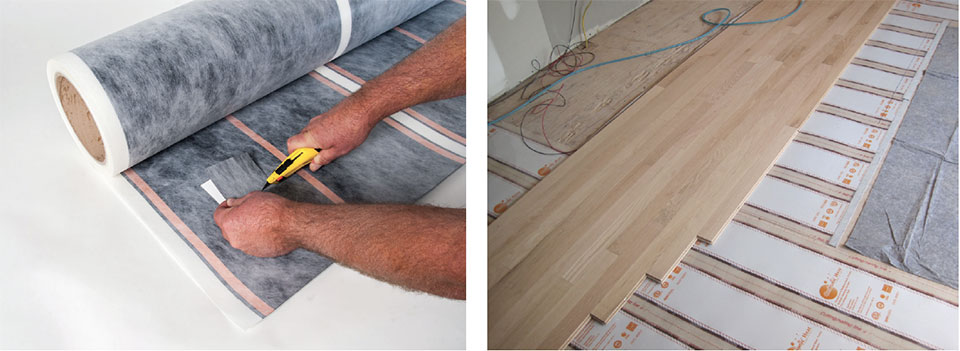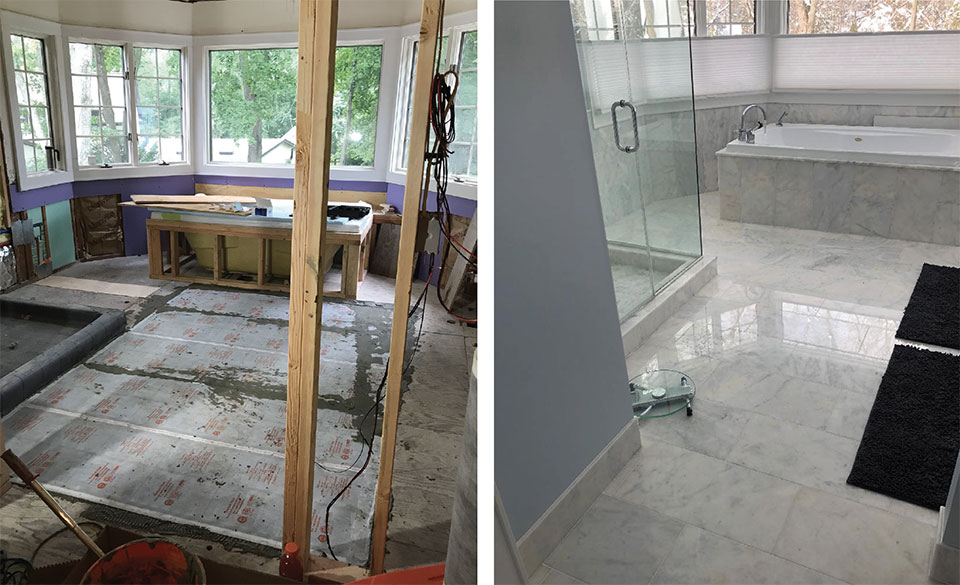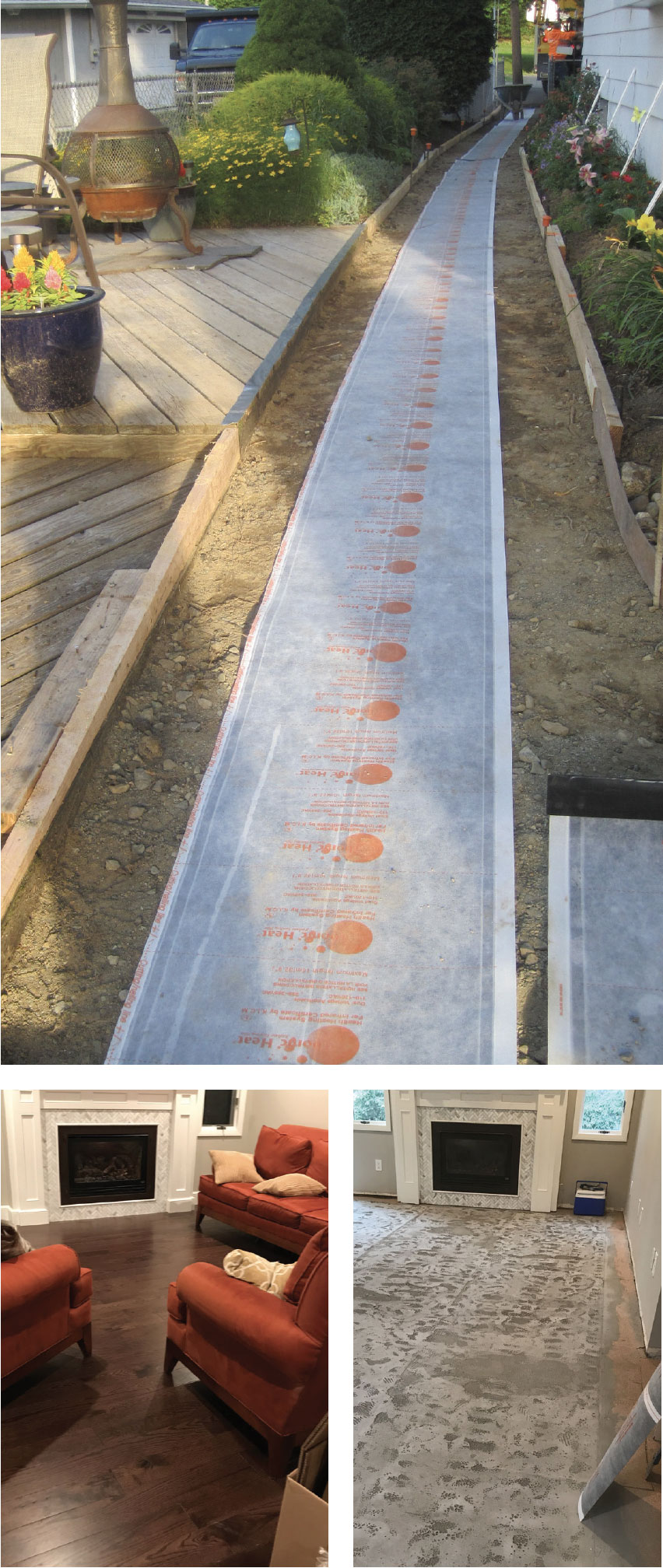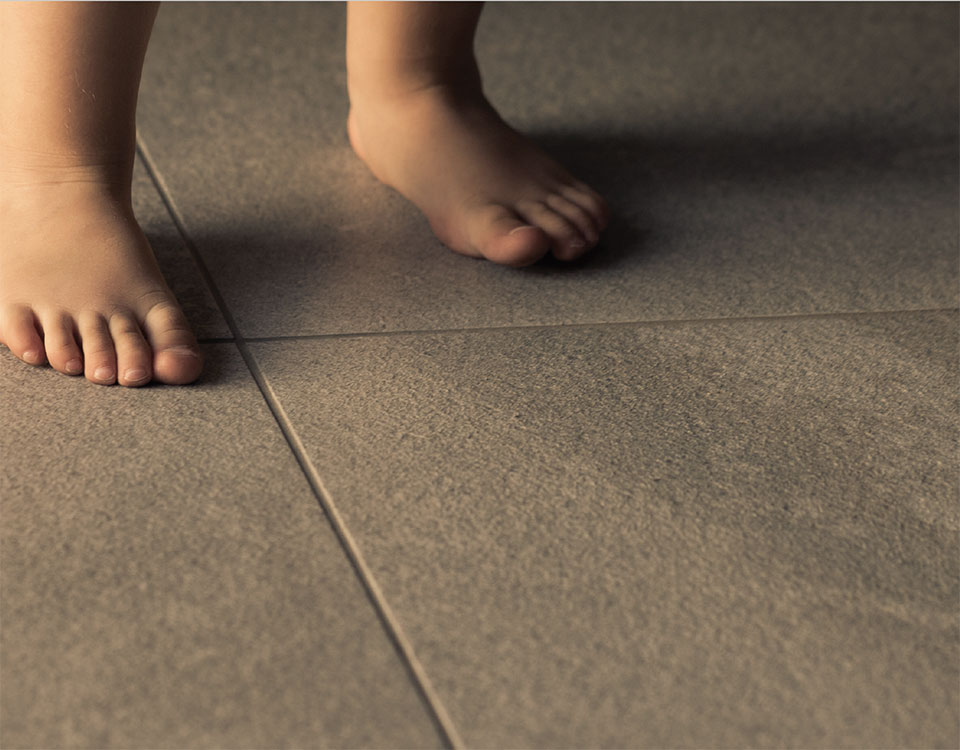by Victoria Plasse
“This product is amazing, it is the easiest to install and the most effective heating product I have found. Not only is it simple and easy to install – it works great. And that means lower heating costs for my customers.”
–Eric Chesnik, President, EC Electric, Sun Valley ID
Resistive technology is irresistible, when you know what resistive technology is.
Heating and mountain living are an inseparable duo. Long winters with shorts days, tight mountain valleys, and the economic drive to be as energy efficient as possible make the topic of how best to heat your home a big discussion.
“The most common types of radiant heat are electric wire systems. They are complicated, delicate to install, and must have thin-set to create a somewhat even thermal mass. Hydronic systems are much more complex, require a dedicated mechanical room for the boilers and pumps, and require semi-annual service. Carbonic Heat is the new paradigm for radiant heat. It comes in a roll and is quick and easy to install,” explains Rick Ryerson, Executive Vice President and CFO of Carbonic Heat Corporation.
What makes Carbonic Heat different than other options for radiant heat? Carbonic Heat uses resistive carbon technology. Ryerson’s company essentially applies (prints) carbon onto plastic sheets and embeds flat electrical wires (buss bars) that when electrified cause the carbon between the buss bars to heat up.
Carbonic heat is priced competitively with other electrical heat options that are also wire systems, according to Ryerson. “The big advantage is that it can be installed in about 20% or less of the time it takes to install other systems. 100% of the electric current is converted into heat. Carbonic Heat heats evenly across the entire surface. Wire systems run at 120 to 140 degrees and are reliant on having a thermal mass generally thin-set to warm between the wires. Carbonic Heat, with the even heat across the surface, heats to 85 to 90 degrees Fahrenheit and creates its own thermal mass,” explains Ryerson. Ryerson also adds the benefit that Carbonic Heat is a good application for solar power, as panels convert to electricity, which, in turn, convert to heat. Solar energy may be stored in batteries to continue to run after sunset.

Ryerson wasn’t always talking about electrical heat sources. He explains, “I have been a real estate developer, with a project management background. I was once with the largest real estate development company in the nation, as an executive officer and land use approval specialist. I was involved in the development of several thousand apartment units and over three million square feet of office and industrial space.” Ryerson’s background gives him an excellent perspective on what works and what doesn’t, and what the level of quality should be.
Resistive technology refers to using carbon material to produce heat with electricity. It’s this incredibly thin layer of material that gets placed atop the subfloor, under nearly all types of flooring, making it an incredibly savvy option for remodels, especially remodels in mountain towns. Many homes have concrete slabs on the first level, but Ryerson says there is a specific approach to the remodel. He explains, “It is recommended that a ‘thermal break’ be installed atop the slab and under the Carbonic Heat. Heat will be drawn to the cold first; the insulation assures a faster heat-up in the room. Otherwise, it would heat the cold slab first.”
According to Ryerson and a good spec sheet, it seems that Carbonic Heat is an especially wise choice for the inter-mountain area. Ryerson explains, “The inter-mountain area has lower electrical rates than the rest of the nation. The product is very effective in heating from both resistive joule heat, warm to touch, and radiates Far-Infrared heat, which is healthy heat like the sun provides. It is the go-to product for remodelers upgrading their homes. The film is thin, about two business cards thick, installs very easily, makes for a great DIY for people. There is an insurgence of ‘Fix and Flip’ people who are looking for cost-effective solutions, both with first dollar cost and eco-friendly pass-it-on, as a Green Building material. This is gaining traction over conventional hot air blower furnace systems. It is interesting to note as well that in many northern tier countries such as Korea, Japan, Sweden, and Norway, 90% of the homes and buildings are heated by radiant heat. In the U.S., over 90% of the homes use forced air systems, heating the air that heats the room.”
Ryerson doesn’t deny that he’s worked with several notable celebrities, in Sun Valley and nationally. CarbonicHeat Corporation has received acclaim and endorsements from HGTV stars “Boise Boys” and Steve Porino, an NBC Sports commentator best known for covering the Alpine Ski events in the Olympics and the Tour de France. “Steve likes it so much, he has become our spokesman in videos,” says Ryerson.

“Forced air systems blow allergens and dust around. The systems heat the air, which heat the room. Carbonic Heat is solid-state, no moving parts, consistent even heat across the room, quiet inconspicuous heat.”
–Rick Ryerson, Carbonic Heat Corporation
Ryerson’s product is the thinnest on the market, available to be retro-fit, is lightweight, and requires no floor build-up so there is no concern for adjusting door heights. The sheets can be installed under all flooring types—carpet, tile, stone, Luxury Vinyl Tile (LVT)*. The cost of materials remains low and competitive with other radiant heat options. The install time is minimal and allows for product and flooring to be installed in the same day. 100% of electricity (Ryerson notes that pricing is regularly declining nationally) converts to heat. As he puts it, “It is one and done. Carbonic Heat has zero maintenance, and a lifetime warranty to the original owner. Other products have a much shorter warranty, and hydronic systems have expensive annual maintenance, as well the boilers and pumps wear out and need to be replaced over time. Also, if hydronic systems leak it is a terrible expense to jack up the floors and replace the piping.”

But it’s not just the ease and energy efficiency, there are significant health benefits to carbon heating options as well. “Forced air systems blow allergens and dust around. The systems heat the air, which heats the room. Carbonic Heat is solid-state, with no moving parts, consistent even heat across the room; it is quiet, inconspicuous heat. Because of these factors, Carbonic Heat is the best overall heat solution, in a system by system comparison,” states Ryerson.
Notable LEEDS expert architect Alicia Silva of Mexico City has endorsed the product regularly and recommends it highly to her clients. According to Ryerson, Mexico is often thought of as hot and rarely needing heat. “Mexico City is at 6,000 feet elevation and gets cold. Most structures are masonry and old, with concrete floors. Our product is an easy retro-fit and works well in these conditions. Our product is warmer at the floor than the ceiling and heats the objects in the room. No need for duct work, or floor build-up. It is silent comfort when needed, as needed,” shares Ryerson.
With all that going for it, how could anyone resist a product that nearly answers all the needs of feeling a warm and cozy solution while enjoying the austere temperatures and weather that come with mountain living?
Clearly Ryerson and his affiliates are working anywhere their work is requested. Part of the core business model is custom kits. With the aid of their proprietary software, they are able to cut and number the material and ship it out as a kit, for an incredible easy installation. The kit is made up and drop-shipped to customers. Alternatively, the product may be purchased from most major electrical supply houses. And there are also installation teams that are available, capable of working with such a high level of performance and integrity that their participation makes for an easy fit onto any construction project team.
“Distance means nothing,” says Ryerson. And he’s right. They have a 26-minute presentation specifically for the architect, engineers, designers, and contractors. It provides an overview of heat options and is available online along with a thorough education and resources for Carbonic Heat. The presentation is on par with the product; actually, it’s been deemed eligible for Continuing Education Credits, via the AIA.
There seems to be little reason to resist resistive technology. Its efficiency is profound from all angles. It’s a product that can be cut to fit nearly all rooms, do its job, and save money—that’s pretty much irresistible.
